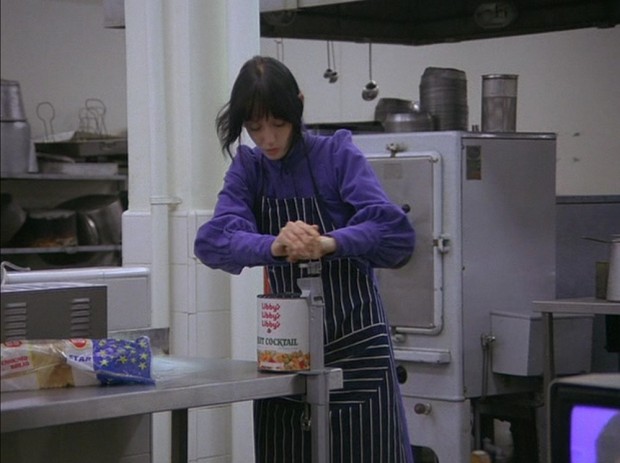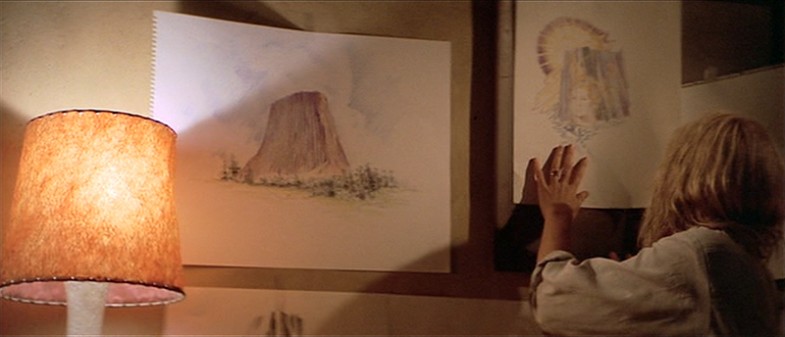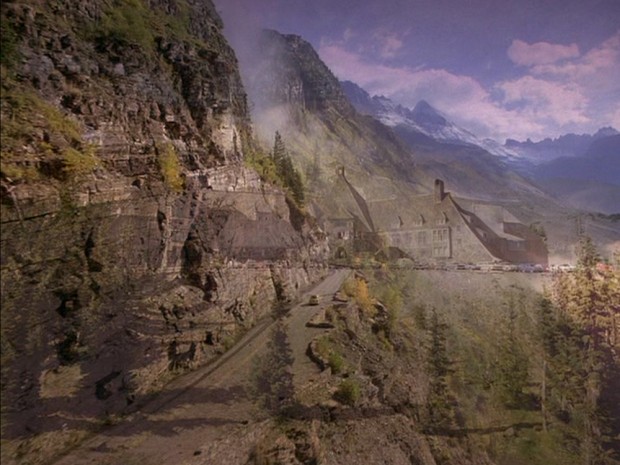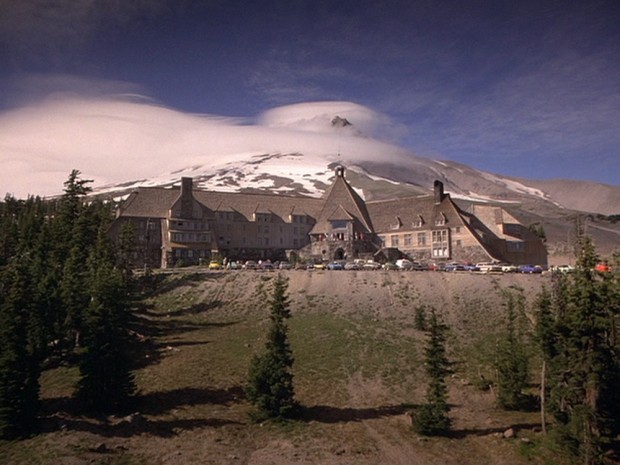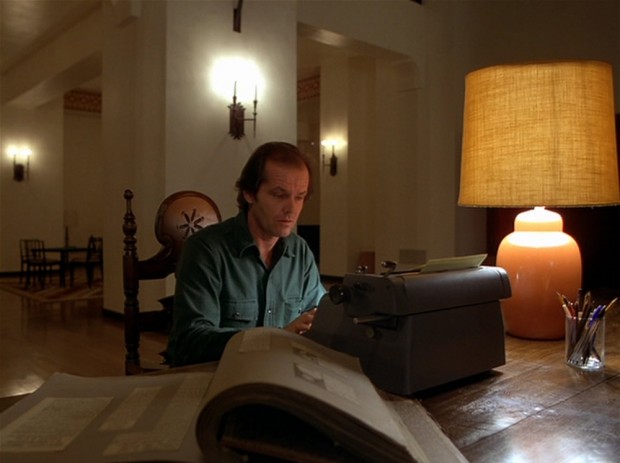
Go to TOC for this film ( (which has also a statement on purpose and manner of analysis and a disclaimer as to caveat emptor and my knowing anything authoritatively, which I do not, but I do try to not know earnestly, with some discretion, and considerable thought).
The fact that I'm going to draw a comparison between The Shining and Close Encounters of the Third Kind doesn't mean I think there's a story line hidden in The Shining wherein aliens are responsible for the strange goings on at the Overlook. No. However, recollecting that Kubrick's supposed first choice for Danny was the boy who featured as the abductee in Close Encounters, my thoughts did return to scenes in each of those films that suddenly seemed to me to be curiously similar thematically and visually, and caused me to wonder if Kubrick may have been intentionally referencing Close Encounters.
In The Shining, the Tuesday opening shot of the mountain superimposed with Wendy opening the great can of fruit cocktail in the kitchen I've always thought of as a kind of cutting the top off the mountain shot. Kubrick has already, in earlier opening shots of the Overlook and the mountain beyond, created a link between the natural environment and the man-made, the steep angles of the lodge mimicking the mountains, much as in the very opening shot of the film the small island in the lake, with its trees, echoes in miniature the mountain far beyond, presumably this very one. Now, in the Tuesday section, we have this shot of Wendy opening the can of fruit cocktail, and it's the last we shall see of the mountain in the movie. After this, the snowstorm rolls in and the mountain behind the lodge remains hidden ever after. That we never see the mountain again is a reason why I've thought of this as the cutting-off-the-top-of-the-mountain scene.
Kubrick uses doublings a lot, and he's not eccentric in this or an isolated director to have done so. Doublings are common in films and literature. In Close Encounters we have also doublings, echoes of Devil's Tower in the sculptures and drawings that those "called" to Devil's Tower are compelled to make in their efforts to interpret and comprehend what they don't even realize is an implanted message. Roy Neary struggles with his, not quite getting it right, until he accidentally dislodges the top of his mountain sculpture. He then has an a-ha moment that is signified by an explosion on a television screen behind him, his daughter watching a Marvin the Martian cartoon. He knows. This is the thing.
The vertical stripes on the apron Wendy wears, superimposed over her own mountain, serve to possibly link the mountain of The Shining more emphatically with Devil's Tower which has the curious feature of being vertically scarred with deeply set markings. This giantess image of Wendy looming over the mountain makes its terrain look very much like Roy's sculptural attempt at recreating Devil's Tower and its environment, right down to the miniature trees.
Another interesting thing is what follows Neary's dislodging the top of the mountain and Wendy's opening of the can of cocktail superimposed over the mountain top. Both mountains then become off-limits territory. The Overlook, yes, already feels isolated and off-limits, the staff removed since Halloween, Danny warned to stay away from Room 237, but the hotel was not yet cut off entirely from the rest of the world. It is as Wendy continues preparing the meal, pouring out the can of fruit cocktail, that she hears on the television how the search for Susan Robertson, a woman missing in the area ten days, is going to be called off due a monster snow storm rolling in. The sense of things off-limits is immediately repeated with Danny portrayed for the first time as feeling compelled to approach Room 237. The family has been in the Overlook for over a month, and perhaps Danny has felt this attraction before, but it is only now that Kubrick depicts it, and we are given to understand that this is the first time Danny has ever attempted to open the door. Again, the idea of off-limits territory is followed up with Wendy visiting Jack in the Colorado Lounge and his resulting tirade that she is never to enter the room again when he is in there, Jack cutting himself off effectively from his family at the very least by his attitude.
Isolation and off-limits becomes the rule in Close Encounters when Neary dislodges the top of his mountain sculpture. He had been dangerously close to alienating his family in his attempt to make sense of an undefined obsession by trying to express it in sculpture. That morning, he was prepared to destroy all evidence of his compulsion, and was in the process of doing so when he had the a-ha moment. His wife, waking after a tumultuous night, was also prepared to reconcile and apologize, but then she finds Roy pitching shrubbery in through the kitchen window. Convinced he's gone crazy, she packs up the kids and leaves. Roy Neary returns to his mountain and continues his work. In the next scene he is ineffectively attempting to placate his wife on the phone when the television intrudes with, first, the idea of a message via a soap opera. One of the characters is knocking on a door saying he has a message for Julie Anderson, then when she answers the door he tells her that they must talk. Foreboding music plays. This idea of the message is followed by a commercial featuring the Budweiser horses, then a special newscast follows. Its footage is of the real Devil's Tower, and the announcement that an evacuation order is being enforced for miles around Devil's Tower. Jillian, in a desert hotel room, sees the same broadcast, and intuits that she must get to Devil's Tower if she is ever to see her missing son again. She, like Roy, had been trying to express their communal obsession, not knowing what it meant. That obsession as perfectly visualized (created in art) as they can manage, they then see the newscast on Devil's Tower, and know this is it. What they were making was just a pale representation and now they must go to the real place, even though they are being warned away from it. They are magnetically drawn to the tower which, in essence, they've already visited interiorly in intimate detail and are knowledgeable of its terrain. Bravely, as in a fairy tale, they outwit, one by one, forces that would keep them away from their destinies.
In The Shining, Jack also feels as if he was formerly at the Overlook, as if he knew what was around every corner, but his uniting with that compulsion is his doom. Close Encounters is a feel good movie and these destinies pursued are uplifting. In Jillian's case, she must go to Devil's Tower in order to be there to meet her son when he is returned. It's not explained why her son was abducted, which makes it essential that Julian go to Devil's Tower, if it's just for Roy to find Jillian and Jillian to find Roy and to help each other. The Shining is not a feel good movie. Warnings to stay away are ignored, and the family is sucked into a vortex of horror. But they had to go to the mountain because that's the way it is with fairy tales. And Danny had to enter Room 237.
One of Jillian's depictions of Devil's Tower is notable. The camera zooms in on the drawing to the left in the below screengrab, the one of the tower looming over the trees, that is most like Roy's sculpture, but the drawing that Jillian rushes to, in response to seeing the real Devil's Tower on the television, is a center one in which we see what appears to be a sun or bright light behind the tower, and a large representation of her son's face before it. This is the ascending glory of the UFO she will later encounter at the tower, or should we say the lights of an alien intelligence.
One could hazard that this symbolism is also pictured in The Shining. For instance, the prepared stage where the confrontation with an alien intelligence occurs in Close Encounters looks much like a kind of landing strip, a road, and in The Shining we have, on Closing Day, the road on which the yellow VW travels superimposed so that it appears to directly run into the lodge and the mountain beyond, which is revealed as haloed.
In the Tuesday scene where Wendy has the confrontation with Jack in the Colorado Lounge, he telling her she is not to enter again, we have Jack seated before bright lamps, the light casting two shadows that mimic the lines of a mountain or road, suggesting a triangular or a trapezoid shape with the light as the apex. The chairs in the scene have a sunburst design on them as well.
Curiously, when the snow rolls in, though one might imagine the Overlook's interior becoming gloomy, heavy cloud and snowdrifts depriving it of sun, instead all its windows beam so brilliantly with light during the day that we never, inside the lodge, are ever able to see what is outside beyond a border of hedges or benches.
I'm not going to try to sell that Kubrick was referring to the light of the alien intelligence visiting the mountain top in Close Encounters, no, the symbolism is more general here, and the human psyche, through stories and legends alone, is pretty indelibly scored with the idea of mountain top ascensions accompanying the possible deliverance of messages from higher intelligences that either reside above the clouds or condescend to make contact where are found pinnacles of spiritual experience.
Now, where am I going with this? I should rein it back in and direct my thoughts toward proposing a "maybe" "why" for Kubrick's (possibly) referencing Devil's Tower, which may or may not answer the reason for those images from Kubrick's 2001 below, which you're no doubt already noticed and are wondering, "What's that about?"
First, not thinking in terms of Spielberg's aliens here, but instead a higher order of intelligence, whatever it might be, what do we have in Close Encounters but the appearance of psychic and physical arrows pointing toward where that meeting will transpire. Which, yes, is "aliens" in Close Encounters, but it's also Jimminy Cricket serenading Pinocchio's desire to be a real boy with the song that wishing upon a star will make your dream come true. In 2001 we have a variation of this with superior intelligence manifesting a monolith that provokes evolution, and invites humans out to Jupiter for an encounter. The "alien" or superior intelligence that does the inviting is never forthrightly revealed, but there is a scene in "Jupiter and Beyond the Infinite" where Kubrick perhaps provides a glimpse of a sort, and by this I mean simply an eye that connotes being seen. It's after the space pod as cosmic sperm diving into the great unknown. The cosmic gases and plasmas and stars reform to briefly form the following image.
And if you look at that and think, "Wow, am I seeing the stars and gases reform into cosmic eyes looking back at ya?" but are unsure, because it's all a matter of pareidolia, then consider the responding image to that one above.
Dave Bowman's own eye looking right back at it.
Kubrick immediately follows this up with what could be the letter "i" against a backdrop similar to the same color palette as we'd observed with the cosmic eye.
Again, a mirrored eye follows in response. It is the same image as above only colored differently.
Or maybe you don't see the cosmic eyes because your monitor's contrast is such that it doesn't come across, or it's a figment of my imagination after all. Let's assume, for the moment, the eyes are there. What has this to do with The Shining? Kubrick repeats themes in all his films, from one to the other, composing his films so they even form a kind of dialogue with each other via echos, and I look at Kubrick's possible referencing of Close Encounters as being perhaps a way to second-hand reference 2001. And maybe it was just plain fun to do.
Approx 1900 words or 4 single-spaced pages. A 15 minute read at 130 wpm.
Return to top of page
Return to Table of Contents for "The Shining" analysis
Link to the main page for all the analyses


